In 1874 when the railway bridge and line were under construction over the Dawson River at Boolburra, the Education Department received representation to give children the opportunity to be educated.
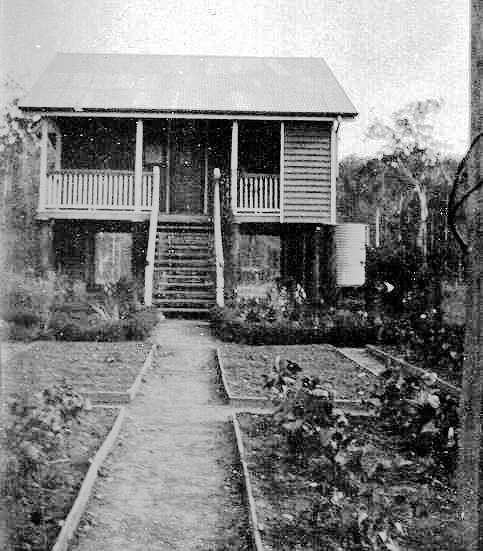
Boolburra school building.
A Mr Sinclair Sutherland wrote (July 31, 1874) offering his services, saying, in part:
I have had some experience as teacher in the British Army having had a junior class in the regimental schools at Aldershot and Devonport. I have not passed any examination in Queensland but in the urgency of the present case, place my services at your disposal till the appointment and arrival of a permanent teacher.”
Building the bridge was a time-consuming task and the workers and their families accounted for a good-sized community.
A letter dated June 12, 1874 from a William Robertson, noted that £55 had been raised by subscription from 41 people and that a committee of five had been appointed to act as trustees.
They were: Messrs William S Robertson, Robert Tait, William Reid, James Mulvany and James Duffy.
In a letter of July 26, 1874, Robertson advised that £67 had been placed in the savings bank at Gainsford to the credit of the Board of Education in trust for the establishment of the primary school at Dawson Bridge (Boolburra).
Robertson wrote: The committee will guarantee that thirty pupils will be in regular attendance.
In a letter of September 5, 1874, Sinclair Sutherland wrote:
I have the honour to inform you that I opened the provisional school at Dawson Bridge on Monday, 31st August, 1874. The first days attendance numbered 27. Having received several applications from parents of children unable to attend the day classes to open an evening class I did so on Tuesday evening 1st Sept. Will you kindly inform me whether the children attending this class are to be included with the day scholars and if the Board will allow books, etc, for their use. Those at present attending the evening class are fair readers; but are backward in the other branches; and I have only one fourth and one fifth book in the school.
Starting point
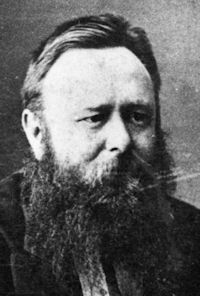
Robert Ballard.
Approval had been given for a provisional school to operate and so Boolburra became the 202nd public institution for learning to be opened in Queensland.
There was no officially constructed building at this point but rather a disused building from the rail construction was made available as Mr Robert Ballard, the railways’ chief engineer, on the project was to write in September, 1874:
…there is a certain bark humpy, also a cook house of a similar construction unoccupied at the Dawson which the Rail Department is willing to place at the disposal of the Board of Education, and that I have inspected these buildings and can see no objection to them being occupied.
Sinclair Sutherland wrote on September 31, 1874 that there were now 49 kids attending day school.
By November, the committee was suggesting that the school would need to be larger than planned because of the number of pupils and that the cost would be £600. They also proposed a house for the teacher.
Building details
In December 1874, after William Robertson had left the district, A K Pennyquick, the new secretary, wrote:
I have to reply that the sum collected is £80 pounds and that this amount is all we expect to be able to raise. This would with the government grant amount to £240. We can erect a school here to suit the requirements of the place, weatherboarded and shingled for about £120. This would leave a similar sum for the dwelling house. The school house can be erected of similar material. The steam saw mills 7 miles from here delivers timber at 23/6 per 100 feet and a chapel large enough to suit for a school for 70 scholars but having no flooring or verandas has just been erected and completed for £83. Studs and weatherboards of hardwood and the roof of Hobart town palings. The difference in cost would be the addition of the 2 verandahs, windows and flooring which could be all done at the cost of £120 pounds. This township is at present large and a great many inhabitants in the neighbourhood which rises from the railway works now in full operation. When the railway extension is open beyond the Dawson River, in about 18 months, a very small population will only be here, not sufficient I am of opinion to maintain a school for the reason that the country in both sides of the Dawson River is unsuitable for any sort of (indistinguishable word) being all scrub and most part bad soil and bad grass, the community at present is entirely made up from the number employed in the railway works. I have therefore from these explanations to leave the matter in your hands hoping you will do the best for our interest. A school and house of the sort referred to could be put up in a few weeks by carpenters on the ground here and if you can give us plans for buildings to suit for the number of scholars at the figure named. They could be erected without delay.
This letter was extensively annotated by a dept officer and included the observations:
A provisional school is now in operation at Dawson Bridge and if the facts are as (Mr P) the writer states, such a school would suffice for the requirements of the place. It would be folly to erect permanent and costly buildings for the use of a population which is certain to melt away in 18 months. It would not be desirable to incur any considerable expenditure in the erection of buildings.
Big water

Boolburra in flood. The railway line is between the tank and station building. The school site is beyond that.
Boolburra apparently is an Aboriginal word meaning big water which, looking back, is entirely accurate knowing how the area floods.
Sinclair Sutherland sent the following telegram dated March 4, 1875 to the secretary, Board Education, Brisbane:
School house completely under water everything lost escaped with life only. W.D.S.Sutherland.
In a letter dated March 15, 1875, Sutherland wrote about the flood and requested school requisites.
In April, Pennyquick wrote:
from the disastrous effect of the late flood at the Dawson, the majority of the inhabitants (subscribers to the school) have left the place and are now settling at Herberts Creek 5 miles below the Dawson (at Edungalba) and at the 7 mile township, (Duaringa) 7 miles beyond the Dawson where will be permanent stations for the Great Northern Railway whereas no station will be at Boolburra..”
In July, 1875, Pennyquick sent telegrams seeking plans for the school for the contractor.
Duaringa connection
By March, 1876 there seems to have been a move to build a school at the 7 Mile (Duaringa).
Pennyquick wrote:
With reference to the erection of a school at the 7 mile with the funds subscribed at Dawson Bridge, I wish to add that it is quite evident a temporary place is all that is requisite at 7 mile. The railway is being extended at so rapid a rate that it will be beyond that place in a few months – the platelayers are beyond there already. For the time being the largest number of children will be located there (7 miles) and it might be more desirable on that you arrange for the transfer of the teacher from this place to there – as after this week the people will be well nigh cleared out of this place.
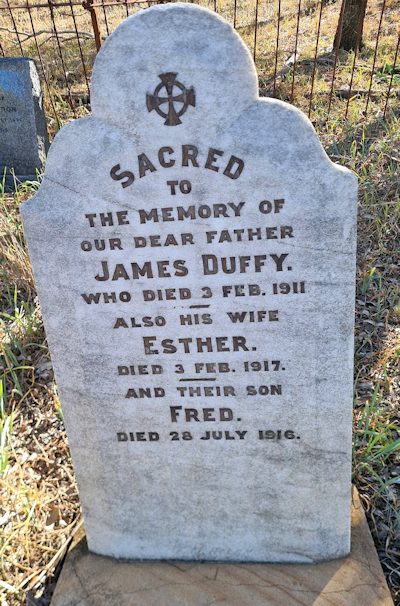
James Duffy’s headstone at the Boolburra cemetery.
By August, the idea for a school at the 7 mile fell through “for want of anyone there taking interest in the matter”. Also, James Duffy who by this time was secretary wrote:
the subscribers are anxious to know if their money will be returned by the board. The teacher, Mr Sutherland, had also gone. The old building is sufficiently good for the temporary purpose – we had it repaired and cleaned since the flood.
Some correspondence from Ballard dated 25 September 1876 refers to only 18 children in the neighbourhood and that the population “is not permanent”.
He wrote:
I may state that the existing population there appears to be still lingering in consequence of the works in progress at the bridge. I am of the opinion that when the bridge is finished, or in about 12 months, Boolburra will become a thing of the past
Ballard was right in one sense but it took more than 12 months.
James Duffy writes
In March, 1877, Duffy again wrote seeking a provisional school be established saying that fees from the temporary/unofficial one by Miss Mary Ann Simpson weren’t sufficient to support her.
On 13/8/1877 the provisional school was approved and Miss Simpson appointed teacher.
A Mr/Miss D.Celvant (name indecipherable in original) was the second teacher followed in March, 1879, by Mrs Mary Matson, recently widowed and with four children, appointed on a salary of £60. By December she had resigned and Annie Kehlet was appointed in her place.
From 1883 until 1914 when ill health forced him to retire, Patrick Murtagh was charged with the education of a couple of generations of young country children.
The money raised for a school by those railway workers who first lived at Boolburra had to be refunded. Those who remained had to go through the process again.
Building completed
They succeeded and a letter of October 26, 1892 gives details of the contractor, Francis Holmes, who built Boolburra School for £98 2 shillings and 7p. (Holmes also built other public structures such as Emu Park railway station).
Information on this is in various letters from the then school secretary, John Nally.
Miss Maude A Gallagher replaced Mr Murtagh to be followed in 1915 by Clara Torrens and Daisy White, and in 1917 by Elsie Jelbart and Amelia Ridgway. In 1920, Belindea (an unusual spelling) May Walsh took over to be replaced in 1922 by Eileen Delaney.
In 1917 there was a significant incident at the school when an irate Mrs Cagney, of Avondale Farm, marched into the classroom, confronted the teacher, Miss Elsie Jelbart, and demanded she apologise for calling her son, Norman, a liar.
Cagney complaint
Mrs Cagney then wrote a letter of complaint to the department. Miss Jelbart’s defence was:
Norman Cagney denied misbehaving and I was satisfied until his sister informed me that he was misbehaving. He then admitted his fault and then made use of the expression complained of and I punished him also for telling the untruth. Nor is it the first time he has been punished for this same fault. His mother told him to tell me to apologise to him and I refused. Mrs Cagney then came to me, at the school and in the presence of the children demanded an apology to her son and she abused me. Her manner was threatening also. Under the circumstance I could not apologise. In a way I feel sorry for the remark, but he really deserved it. Norman informed his schoolmates that his mother was going to make me apologise. The children have been told to disobey me in school and have been impertinent beyond endurance. To be candid, that family – the first people with whom I boarded – since I left their place, have done their utmost to make everything unpleasant for me, which is the outcome of bitterness. Accommodation with them was not suitable and I informed Mr Denniss, Inspector, of it and he advised me to leave.
It was a most unsavoury situation which had a quiet ending when Miss Jelbart resigned soon after to be married. The file was marked with the comment that “no further action is deemed necessary”. Young Norman had obviously abused Miss Jelbart and copped a whacking.
Ray Dobbs
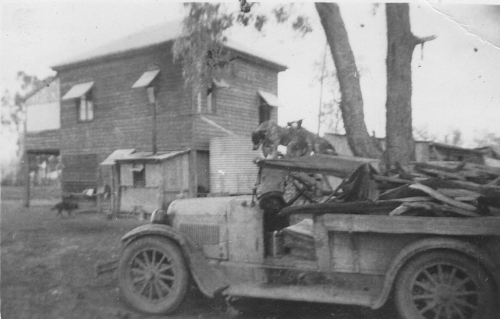
The Dobbs family house at Boolburra around 1930.
Ray Dobbs related the following story about Norman which may be the incident which led to the showdown between Mrs Cagney and Miss Jelbart.
Going home after school one afternoon we found a koala up a tree. Norman found a long sick and started to poke it to make it cry. Just then the teacher, Miss Jelbart came along on the other side of the railway line and yelled out at them. Norman took no notice so she started to cross the railway line so they took off. It did not help as at school next day we copped the cane
When Miss Delaney left in October 1923, she warned the department of the poor state of accommodation:
My present place of abode is rather rough. Until this year I was two miles away from the school and only that I was leaving I am afraid I would not have removed. Just recently I found out if my successor disapproves of where I am there is another woman will take her (or him) quite close to the school. I beg of you to keep this private as if the Boolburra people found this out if would be hard on me. In these little places one has to keep very quiet and only think…
Miss Silver arrives
Where Miss Delaney stayed is not clear because when Miss Margaret Isabella Silver arrived to replace her, she boarded with Charles and Elizabeth Dobbs.
It could be assumed that Miss Delaney had been boarding with the Dobbs’ and that she was recommending her successor board with Miss Duffy.
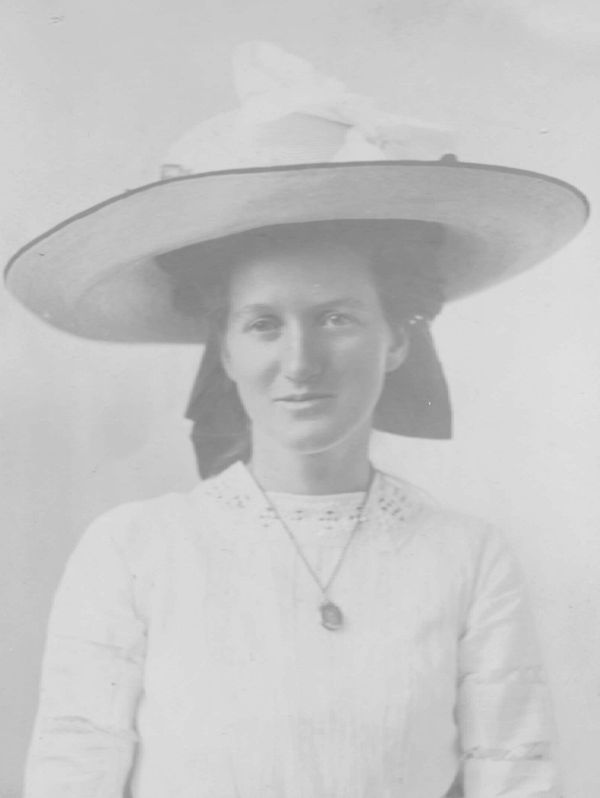
Margaret Isabella Silver about 1915.
She wrote that she had previously boarded “two miles from the school”. This was possibly with the Cagney family at Avondale farm.
If the accommodation were unsatisfactory, Miss Silver did not complain in the two years she stayed there. In fact, she ended up falling in love with the young man of the house, Alex Dobbs.
She was paid a salary of £180 and in that time had to deal with low attendance, floods and epidemics. The worst was in August 1925 when mumps, influenza and measles swept the district in what was a cold, wet end to winter.
In a letter to the department over the dwindling number of pupils, Miss Silver, wrote in May, 1925:
I have to honor to inform you that that the enrolment is now eleven, so I trust that the average attendance for the future will be over 9. The low enrolment for January and February was due to two pupils having left school and one being away on a holiday. The latter has returned and one new pupil has been admitted.
The end in sight
The school was in its death throes when Ivy McLeod replaced Miss Silver for the remainder of 1925. Gladys Kidd took her place in 1926 and was appalled by the living conditions at Miss Duffy’s.
In a letter dated January 29, 1926, which dealt with low attendance, she also noted:
My accommodation here is very far from satisfactory – it being very rough. Should the school close, I would like a similar one on the Central Railway Line within easy reach of my home centre Emerald as my aged father and mother there reside.
A few days later, the department received a letter from the school’s honorary secretary, Mr Arthur Goodwin:
Miss G.F.Kidd advises me that she has wrote you that she cannot stay here as a teacher and that she had wrote to that effect. I don’t know if Miss Kidd told you that the place she was staying at was unsatisfactory. I admit it is not the best place in the world but it is the only house here that would take a teacher in so we had no choice in the matter. I do no wish to leave here. I have a wife and nine children so it would be a big expense for me to shift. I am only a working man so you will see what a shift to me would mean and if I have to shift it would mean that school would never open again as 5 of the pupils are mine.
Obviously fed up with the situation, the next day Miss Kidd sat down and poured her heart out over the situation:
I feel it my duty to write again, relative to the accommodation which I am forced to contend with here, and, as this is the only available place, I anxiously await your instructions. The accommodation is very dirty and I am unable to sleep at night on account of bugs. The food (cooking and eating utensils) are also far from clean, and one cannot fancy any food here such filth and dirt exist. How the late teacher (Miss McLeod) stayed here for 3 months I do not know. The place is also over-run by dogs and cats, which are fed at the same time and place as I am supposed to do. I trust you will treat this matter confidentially and urgently, as it is very hard for me to put up with these conditions and the secretary here agrees with me.
Poor report
A few weeks later, District Inspector F. Baker, came to Boolburra to see where Miss Kidd was staying. His report was damning and included the following statements:
The matter was discussed with Mr A Goodwin, the parent most deeply interest in the continuance of the school. He informed me that there was absolutely no other place except Miss Duffy’s. Accompanied by him, I visited Miss Duffy’s place and was shown the room allotted to the teacher. It is large enough, but it did not seem clean, from what I could gather, I believe it to be infested with vermin. Miss Duffy is a woman of very low intelligence; in my opinion, she is mentally sub-normal and I was informed on what I conceive to be very good authority, that she is the mother of two or more illegitimate children.
Finding: Miss Duffy’s place does not provide suitable accommodation for Miss Kidd or for any other teacher. Though on the day of my visit the total number of pupils was present, the average attendance does not warrant the continuance of the school.
Recommendation: That the school be closed, and that the present head teacher, Miss Kidd, who is a worthy servant of the dep’t, be transferred to some school on the Central Railway. If no head teacher has yet been appointed to Blackwater it is recommended that she be appointed head teacher of that school.
Within weeks, the school was closed and by August 1928 the building was removed from the site, purchased by James J Duffy for £20.
It was the end not only for the school but also, symbolically, to a community that 50 years previously saw a substantial future for the area.
The town plan was laid out but the area was flood-prone and it was destined never to be the riverside village that someone envisioned it could become.
NOTE: I’m happy for anyone to reproduce this information. It is my own work and I would appreciate a credit thus – Original work of Warren Nunn, oznunns.com.au
